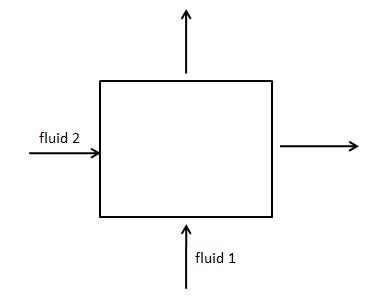Which of the following is true about the flow of fluids in crossflow heat exchangers? O a. Fluids move at an angle of 60 degrees to each other O b. Fluids move perpendicular to each other. O c. Fluids move at an angle of 45 degrees to each other. O d. Fluids are moving in the same direction, in parallel.
Which of the following is true about the flow of fluids in crossflow heat exchangers? O a. Fluids move at an angle of 60 degrees to each other O b. Fluids move perpendicular to each other. O c. Fluids move at an angle of 45 degrees to each other. O d. Fluids are moving in the same direction, in parallel.
Elements Of Electromagnetics
7th Edition
ISBN:9780190698614
Author:Sadiku, Matthew N. O.
Publisher:Sadiku, Matthew N. O.
ChapterMA: Math Assessment
Section: Chapter Questions
Problem 1.1MA
Related questions
Concept explainers
Heat Exchangers
Heat exchangers are the types of equipment that are primarily employed to transfer the thermal energy from one fluid to another, provided that one of the fluids should be at a higher thermal energy content than the other fluid.
Heat Exchanger
The heat exchanger is a combination of two words ''Heat'' and ''Exchanger''. It is a mechanical device that is used to exchange heat energy between two fluids.
Question

Transcribed Image Text:### Understanding Fluid Flow in Crossflow Heat Exchangers
Crossflow heat exchangers are vital in various industrial applications due to their efficiency in heat transfer. Understanding the fluid movement in these exchangers can enhance system design and performance.
**Question:** Which of the following is true about the flow of fluids in crossflow heat exchangers?
- **a.** Fluids move at an angle of 60 degrees to each other.
- **b.** Fluids move perpendicular to each other.
- **c.** Fluids move at an angle of 45 degrees to each other.
- **d.** Fluids are moving in the same direction, in parallel.
#### Explanation:
In crossflow heat exchangers, option **b** is correct: fluids typically move perpendicular to each other. This configuration allows for efficient heat exchange between the two fluids, as it maximizes the surface area available for heat transfer, while minimizing the required physical space.
Understanding the flow direction is crucial in optimizing the exchanger's performance and ensuring the desired thermal efficiency.
Expert Solution
Step 1
To Find :
The correct option .
The diagram :

Step by step
Solved in 2 steps with 1 images

Knowledge Booster
Learn more about
Need a deep-dive on the concept behind this application? Look no further. Learn more about this topic, mechanical-engineering and related others by exploring similar questions and additional content below.Recommended textbooks for you

Elements Of Electromagnetics
Mechanical Engineering
ISBN:
9780190698614
Author:
Sadiku, Matthew N. O.
Publisher:
Oxford University Press

Mechanics of Materials (10th Edition)
Mechanical Engineering
ISBN:
9780134319650
Author:
Russell C. Hibbeler
Publisher:
PEARSON

Thermodynamics: An Engineering Approach
Mechanical Engineering
ISBN:
9781259822674
Author:
Yunus A. Cengel Dr., Michael A. Boles
Publisher:
McGraw-Hill Education

Elements Of Electromagnetics
Mechanical Engineering
ISBN:
9780190698614
Author:
Sadiku, Matthew N. O.
Publisher:
Oxford University Press

Mechanics of Materials (10th Edition)
Mechanical Engineering
ISBN:
9780134319650
Author:
Russell C. Hibbeler
Publisher:
PEARSON

Thermodynamics: An Engineering Approach
Mechanical Engineering
ISBN:
9781259822674
Author:
Yunus A. Cengel Dr., Michael A. Boles
Publisher:
McGraw-Hill Education

Control Systems Engineering
Mechanical Engineering
ISBN:
9781118170519
Author:
Norman S. Nise
Publisher:
WILEY

Mechanics of Materials (MindTap Course List)
Mechanical Engineering
ISBN:
9781337093347
Author:
Barry J. Goodno, James M. Gere
Publisher:
Cengage Learning

Engineering Mechanics: Statics
Mechanical Engineering
ISBN:
9781118807330
Author:
James L. Meriam, L. G. Kraige, J. N. Bolton
Publisher:
WILEY